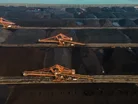Why Coal is Still Very Much Part of Industrial Landscape

The signing of the Paris Agreement in 2015 prompted a global shift away from coal. To date, 75 countries have established carbon neutrality goals for 2050 or earlier.
This surely means fossil fuels such as coal are on the way out, right? Well, not exactly. While it’s true that 100 countries are already coal-free or have set a coal phase-out date for 2040 or earlier, some are still heavily reliant on it for power, while the the world in general is still driving demand for certain types of coal because of its reliance on steel, for which coal currently remains vitally important.
The demise of steam coal -- also known as thermal coal -- has been well documented, as investors shy away from the fossil fuel that fired the Industrial Revolution and has been an energy mainstay pretty much ever since, save for the past decade or so.
Yet one corner of the coal market is thriving: metallurgical coal, otherwise known as coking coal, and vital for making steel.
Metallurgical coal mining still thriving
For their part, steel producers are reliant on metallurgical coal, as it is an essential fuel for the blast furnaces used in steelmaking, providing both the necessary heat and carbon needed to turn iron ore into steel, and is used to produce about 70% of the world’s 1.8 billion tons of steel each year.
The demand for metallurgical coal is coupled to the demand for steel, and why most primary steelmakers have a division that produces coal for coking, to ensure a stable and low-cost supply.
For steel to be greener, producers need to move away from coke-fuelled furnaces and instead use electric-arc furnaces (EAF) fed with steel scrap and reduced iron, and powered by renewable energy, such as hydrogen or electricity.
But the reality is that steelmaking is unlikely to make further significant reductions in its reliance on coke without both a change in regulations and also price incentives, to drive a shift in steel investment and consumption.
Green steel expensive and has low market traction
The price premium on green steel is around $150 a metric ton, and Reuters reports that even a relatively modest premium on green steel makes it unattractive to much of the market, with automotive manufacturing being the only sector prepared to pay a premium for green steel, because it is able to absorb the extra cost into the retail price of a vehicle – and also gain significant consumer kudos for making an environmentally friendly product.
The biggest steel consumers are property and infrastructure, which used a combined 518 million tons in 2024, or 57% of the total. It also points out that high-speed rail uses between 30,000 and 60,000 tons of steel per kilometre. Higher-price green steel remains unattractive to these sectors.
Who are the biggest consumers of coal?
China and India, who are yet to phase out coal power stations.
Almost all of the coal-power capacity under development is concentrated in just 15 countries, with China and India alone accounting for 86%, says Global Energy Monitor (GEM), a body that tracks fossil fuel development worldwide.
The number of countries developing new coal-fired power plants has decreased significantly over the past decade, it also shows.
GEM's Global Coal Plant Tracker results show that countries with coal power under development have fallen from 75 in 2014 to 40 in 2024.
Despite this concentration, and projections suggesting global coal demand could be peaking, GEM says new coal-fired power station proposals continue to outpace cancellations.
In the first half of 2024, more than 60 gigawatts (GW) of coal capacity was newly proposed or revived, it says, compared to 33.7GW shelved or cancelled during the same period.
____________________________
Check out the latest issue of Mining Digital and sign up to our global conference series, Manufacturing LIVE 2024. Mining Digital is a BizClik brand.




